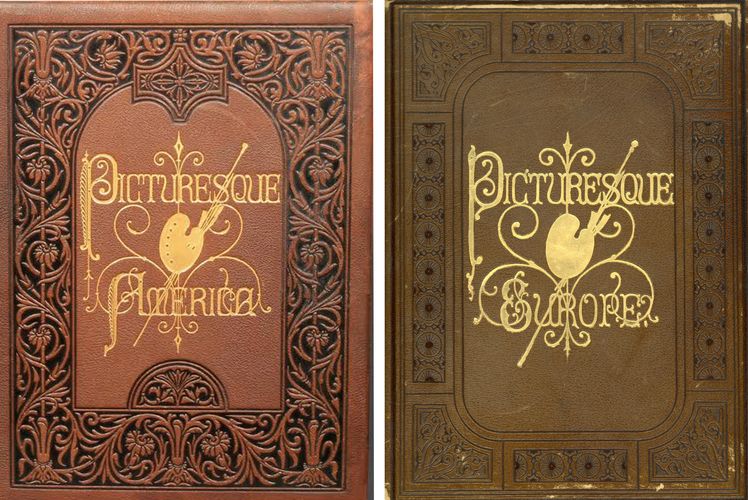The Land We Live In

1870's Steel and Wood engravings featured in Picturesque America and Picturesque Europe
Signed in as:
filler@godaddy.com

1870's Steel and Wood engravings featured in Picturesque America and Picturesque Europe
The purpose of this website is to educate others on the beauty and significance of the amazing artwork and descriptions of the world's most beautiful sites detailed in the 1870's Picturesque America and Picturesque Europe books. 110 steel engravings and 127 wood engravings from these books have been professionally scanned in high resolution (600 DPI 24 Bit) and are available on this website to purchase and download (SHOP). These downloaded scans can be uploaded to your favorite photo producing companies such as Shutterfly, Amazon Prints, Walmart, Snapfish etc. to produce incredible metal, canvas or regular photographic art pieces. Display suggestions are included in this site (ART). With this website, we also hope to eliminate the tragic practice of cutting the actual engravings out of these books for display.
Picturesque America was a literary and artistic masterpiece first published as a subscription book, or a "book in parts," by D. Appleton and Co. from mid-1872 to mid-1874. Beginning in the fall of 1870 and prior to the publication of the subscription book, Appletons' Journal, a weekly illustrated magazine published by D. Appleton and Co., had run a series of articles illustrated with wood engravings titled "Picturesque America." Harry Fenn was the first and most prolific artist for this series, which was expanded and enhanced in the subscription book.
The subscription book, edited by the prestigious William Cullen Bryant, consisted of 48 "fascicles" printed twice a month at a cost of $.50 each, totaling $24.00. As many as a million copies of this serialized publication may have been produced by 1880. Most sets distributed were later bound in two volumes, according to the subscriber's wishes, either by the Appleton firm or by the subscriber's local binder. The full leather binding was the most expensive, while primarily cloth binding, with leather corners, was cheaper. Each "fascicle" contained one steel and 5 to 20 wood engravings of scenes of the American Landscape deemed "picturesque" at the time, and the descriptions combined with engravings added up to over 1,100 pages. Representing the first comprehensive description of the entire continental American landscape, it served to help heal a nation still suffering from the wounds of a terrible civil war as well as to foster a growing national pride. Documenting the variety and wealth of the new nation's natural resources, these books were enjoyed by middle class as well as wealthy Americans for years after their publication. Numerous artists were commissioned by D. Appleton & Company to produce these pictures by pencil, watercolor, or occasionally oil, and the most talented engravers of the time were paid to prepare wood blocks or steel plates for printing the images. Together, they created a remarkable collection of beautiful and varied American land and cityscapes. These volumes were eventually rendered old fashioned by the innovation of photography, but the periodicals and books remain significant collector's items for rare book enthusiasts to this day.
Sue Rainey has written an award-winning book published in 1994, Creating Picturesque America, which is readily available at Applewood Books for $24.95. Sue has also published a book on Harry Fenn entitled Creating a World On Paper, Harry Fenn's Career in Art (2013). This book is available at Amazon.com.
Picturesque Europe was a also a lavishly illustrated set of books, published in twice monthly parts by D. Appleton & Co. from 1875 to 1879 based on their phenomenally successful Picturesque America. Edited by Bayard Taylor, it was subsequently published by Appleton in 1875, 1878 and 1879. It was also published by Cassel, Petter and Galpin in London beginning in 1876 in either four or ten volumes. The books depicted nature and tourist haunts in Europe, with text descriptions and numerous steel and wood engravings. J.W. Whymper was among the engravers and directed the other artists on the project.
From the three books' preface: "The intentions of the editor and publishers of "Picturesque America" have been so cordially recognized by the American people, in the general and unusual favor with which they have received the work, that a companion to it, devoted to "Picturesque Europe," may hope to be equally welcome. Each, indeed, will be found to be complimentary to the other, even where external resemblances in the forms of scenery of the two continents are most manifest".



We use cookies to analyze website traffic and optimize your website experience. By accepting our use of cookies, your data will be aggregated with all other user data.